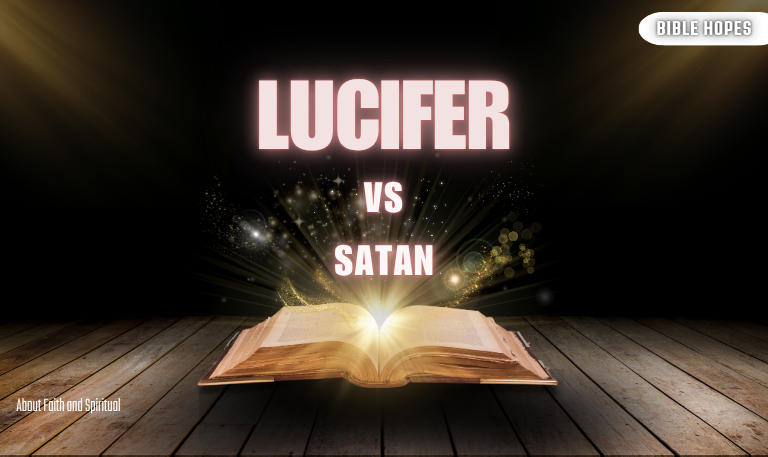The names Lucifer and Satan evoke powerful images of darkness, rebellion, and evil in popular culture and religious contexts. Yet, despite their frequent interchangeability, these two figures have distinct origins, meanings, and roles — both in the Bible and across various religious and cultural traditions.
This article offers a detailed, expert-level exploration of Lucifer vs Satan: Are they the same? How did these figures develop in theology? What do scriptures really say? And how have their meanings evolved in literature, art, and modern spirituality? By the end, you’ll have a clear understanding of the differences and similarities between Lucifer and Satan, their symbolic importance, and why this distinction matters.
1. Origins and Etymology: Lucifer and Satan
What Does “Lucifer” Mean?
The word Lucifer comes from Latin, meaning “light-bringer” or “morning star”. It originally referred to the planet Venus when it appears as the morning star before dawn. This term entered Christian theology primarily through the Latin Vulgate Bible translation.
What Does “Satan” Mean?
Satan derives from the Hebrew word śāṭān, meaning “adversary” or “accuser”. In the Hebrew Bible, Satan is portrayed not as an independent evil being but often as an agent of God, challenging human faith and loyalty.
2. Lucifer in Religious and Cultural Context
Biblical Reference to Lucifer
The name Lucifer appears in Isaiah 14:12 in the Latin Vulgate Bible, translated as “lucifer” for the Hebrew phrase helel ben shachar (“shining one, son of the dawn”). This passage metaphorically refers to the fall of the King of Babylon but has historically been interpreted by some Christian traditions as describing the fall of a rebellious angel.
Lucifer as a Fallen Angel
In Christian tradition, Lucifer has often been equated with a high-ranking angel who rebelled against God and was cast out of Heaven. This association largely stems from early Church Fathers’ interpretations, medieval theology, and literature such as John Milton’s Paradise Lost.
Lucifer in Literature and Popular Culture
Lucifer has become a cultural archetype symbolizing pride, rebellion, and enlightenment. From comics like Lucifer (Vertigo/DC) to TV shows, he is often portrayed with complexity—sometimes as a misunderstood antihero rather than pure evil.
Read Also: The Bible Vs The Book of Mormon
3. Satan in Religious Context and Scripture
Satan in the Hebrew Bible
In the Old Testament, Satan is an adversarial figure but remains subordinate to God. For example, in the Book of Job, Satan acts as a tester of Job’s faith with God’s permission.
Satan in the New Testament
The New Testament portrays Satan more explicitly as the tempter and enemy of God and humanity (e.g., Matthew 4:1-11, Revelation 12:9). Here, Satan embodies evil and opposition to divine will.
Satan in Islam and Other Traditions
In Islam, Satan is known as Iblis or Shaytan, a jinn who refused to bow to Adam and was cast out. Similar to Christianity, Satan represents temptation and rebellion against God.
4. Key Differences Between Lucifer and Satan
| Aspect | Lucifer | Satan |
|---|---|---|
| Origin of Name | Latin: “Light-bringer” (Morning Star) | Hebrew: “Adversary” or “Accuser” |
| Biblical Reference | Isaiah 14:12 (King of Babylon metaphor) | Multiple books (Job, Zechariah, NT) |
| Role | Fallen angel, pride and rebellion symbol | Tempter, accuser, embodiment of evil |
| Cultural Depiction | Complex, sometimes sympathetic figure | Typically evil, antagonist of God |
| Religious Interpretation | Mostly Christian, less prominent in Judaism | Present in Judaism, Christianity, Islam |
5. Are Lucifer and Satan the Same?
The question of whether Lucifer and Satan are the same being has long been debated:
Theological Viewpoints: Many Christian traditions equate Lucifer with Satan, interpreting Isaiah 14:12 as referring to Satan’s fall.
Scholarly Perspectives: Modern biblical scholarship argues Isaiah 14:12 addresses a human king metaphorically, not a supernatural being. Satan and Lucifer represent different concepts originally.
Cultural Influence: Literature and media have popularized the overlap, leading to widespread conflation.
6. Biblical Passages Related to Lucifer and Satan
Isaiah 14:12
“How you have fallen from heaven, morning star, son of the dawn! You have been cast down to the earth…”
— Traditionally linked to Lucifer, describing the pride and downfall of a figure.
Job 1:6-12
— Satan as the heavenly accuser testing Job’s faith.
Revelation 12:9
“That ancient serpent called the devil, or Satan, who leads the whole world astray…”
— A clear depiction of Satan as the deceiver.
7. Lucifer vs Satan in Popular Culture
Lucifer and Satan appear extensively in books, movies, and TV series, often blurring lines:
Lucifer Morningstar (TV series): A charming, complex character based on the comic book, distinct from traditional Satan.
Satanic depictions in horror films: Often as a monstrous evil figure.
Literature like Paradise Lost frames Lucifer as a tragic rebel.
8. The Devil Archetype: Psychological and Cultural Impacts
The figures of Lucifer and Satan contribute to the archetype of the Devil, representing:
Rebellion against authority
Temptation and sin
Pride and downfall
The struggle between good and evil
9. Luciferianism vs Satanism: Modern Spirituality
Luciferianism embraces Lucifer as a symbol of enlightenment, individuality, and questioning authority.
Satanism (e.g., LaVeyan Satanism) often rejects the supernatural and uses Satan as a symbol of freedom and self-empowerment.
Read Also: Calvinism vs Arminianism
10. Symbols and Iconography
| Figure | Common Symbols | Meaning |
|---|---|---|
| Lucifer | Morning star, light, wings | Enlightenment, pride, rebellion |
| Satan | Serpent, goat (Baphomet), horns | Temptation, evil, adversary |
11. Common Myths and Misunderstandings
Lucifer is not explicitly named in most Bible versions as Satan.
Isaiah 14:12 originally referred to a Babylonian king, not an angelic being.
Satan in the Old Testament is not the embodiment of evil but an accuser.
Lucifer vs Satan FAQs
Q1: Is Lucifer the same as Satan?
A: Not originally. Lucifer is a Latin term meaning “morning star,” historically linked to a fallen figure often conflated with Satan, who is the adversary or accuser in Hebrew tradition.
Q2: Why is Lucifer called the “Morning Star”?
A: The term comes from Latin and refers to the planet Venus as it appears before dawn, symbolizing light and beauty before a fall.
Q3: What role does Satan play in the Bible?
A: Satan is often the accuser or tempter testing human faith, particularly seen in the Book of Job and the New Testament.
Q4: How do different religions view Lucifer and Satan?
A: Christianity often merges the two figures; Judaism sees Satan more as a heavenly accuser; Islam refers to Iblis as a rebellious jinn.
Q5: What is Luciferianism?
A: A modern spiritual movement that views Lucifer as a symbol of enlightenment, independence, and the quest for knowledge.
Q6: Are Lucifer and Satan evil?
A: In traditional Christian theology, both represent evil, but interpretations vary across denominations and modern spirituality.
Conclusion
The Lucifer vs Satan distinction is subtle but significant. While they have been conflated throughout history due to linguistic, theological, and cultural reasons, they originally represent different concepts: Lucifer as the “light-bringer” or fallen morning star, and Satan as the adversarial accuser challenging humanity. Understanding their unique origins enriches our grasp of religious texts, cultural stories, and the powerful symbolism behind these figures. Whether in scripture or pop culture, the Lucifer vs Satan narrative continues to captivate imaginations and provoke profound questions about good, evil, and rebellion.



